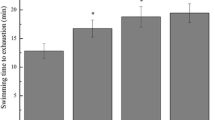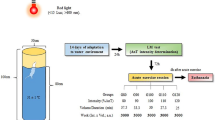Abstract
This study aims to examine the effect of zinc administration on liver glycogen levels of rats in which diabetes was induced with streptozotocin and which were subjected to acute swimming exercise. The study was conducted on 80 adult Sprague–Dawley male rats, which were equally allocated to eight groups: group 1, general control; group 2, zinc-administrated control; group 3, zinc-administrated diabetic control; group 4, swimming control; group 5, zinc-administrated swimming; group 6, zinc-administrated diabetic swimming; group 7, diabetic swimming; group 8, diabetic control group. In order to induce diabetes, animals were injected with 40 mg/kg intraperitoneal (ip) streptozotocin. The injections were repeated in the same dose after 24 h. Animals which had blood glucose at or above 300 mg/dl 6 days after the last injections were accepted as diabetic. Zinc was administrated ip for 4 weeks as 6 mg/kg/day per rat. Hepatic tissue samples taken from the animals at the end of the study were fixed in 95% ethyl alcohol. Cross sections of 5 µm thickness, taken by the help of a microtome from the tissue samples buried in paraffin, were placed on a microscope slide and stained with periodic acid–Schiff and evaluated by light microscope. All microscopic images were transferred to a PC and assessed with the help of Clemex PE3.5 image analysis software. The lowest liver glycogen levels in the study were obtained in groups 3, 4, 6, 7, and 8. Liver glycogen levels in group 5 were higher than groups 3, 4, 6, 7, and 8, but lower than groups 1 and 2 (p < 0.05). Groups 1 and 2 had the highest liver glycogen levels. The results obtained from the study indicate that liver glycogen levels which dropped in acute swimming exercise were restored by zinc administration and that diabetes induced in rats prevented the protective effect of zinc.



Similar content being viewed by others
References
Gavin JR 3rd, Alberti KGMM, Davidson MB, DeFronzo RA, Drash A, Gabbe SG, Genuth S, Harris MI, Kahn R, Keen H, Knowler WC, Lebovitz H, Maclaren NK, Palmer JP, Raskin P, Rizza RA, Stem MP (1997) Report of the expert committee on the diagnosis and classification of diabetes mellitus. Diabetes Care 20:1183–1197
Manna P, Sinha M, Sil PC (2009) Protective role of arjunolic acid in response to streptozotocin-induced type-I diabetes via the mitochondrial dependent and independent pathways. Toxicology 257:53–63
Kuroki T, Isshiki K, King GL (2003) Oxidative stress: the lead or supporting actor in the pathogenesis of diabetic complications. J Am Soc Nephrol 4:216–220
Shay NF, Mangian HF (2000) Neurobiology of zinc-influenced eating behavior. J Nutr 130(5S Suppl):1493S–14999S
Zago MP, Oteiza PI (2001) The antioxidant properties of zinc: interactions with iron and antioxidants. Free Radic Biol Med 31:266–274
Huber AM, Gershoff SN (1973) Effect of zinc deficiency in rats on insulin release from the pancreas. J Nutr 103:1739–1744
Ott ES, Shay NF (2001) Zinc deficiency reduces leptin gene expression and leptin secretion in rat adipocytes. Exp Biol Med (Maywood) 226:841–846
Findik D, Presek P (1988) Zn2+ enhances protein tyrosine kinase activity of human platelet membranes. FEBS Lett 235:51–56
Kennedy KJ, Rains TM, Shay NF (1998) Zinc deficiency changes preferred macronutrient intake in subpopulations of Sprague–Dawley outbred rats and reduces hepatic pyruvate kinase gene expression. J Nutr 128:43–49
Lehmann R, Kaplan V, Bingisser R, Bloch KE, Spinas GA (1997) Impact of physical activity on cardiovascular risk factors in IDDM. Diabetes Care 20:1603–1611
Kim JD, Yu BP, McCarter RJM, Lee SY, Herlihy JT (1996) Exercise and diet modulate cardiac lipid peroxidation and antioxidant defenses. Free Radical Biol Med 20:83–88
Kanter M (1998) Free radicals, exercise and antioxidant supplementation. Proc Nutr Soc 57:9–13
Cordova A, Alvarez-Moni M (1995) Behaviour of zinc in physical exercise: a special reference to immunity and fatigue. Neurosci Biobehav Rev 19:439–445
Singh A, Failla ML, Deuster PA (1994) Exercise-induced changes in immune function: effects of zinc supplementation. J Appl Physiol 76:2298–2303
Lukaski HC (1995) Micronutrients (magnesium, zinc, copper): are mineral supplementation needed for athletes. Int J Sports Nutr 5:74–83
Gleeson M, Nieman DC, Pedersen BK (2004) Exercise, nutrition and immune function. J Sports Sci (London) 22:115–125
Chausmer AB (1998) Zinc, insulin and diabetes. J Am Coll Nutr 17:109–115
Faure P, Roussel AM, Martinie M, Osman M, Favier A, Halimi S (1991) Insulin sensitivity in zinc-depleted rat: assessment with the euglycaemic hyperinsulinemic clamp technique. Diabetes Metab 17:325–331
Rossetti L, Giaccari A, Klein-Robbenhaar E, Vogel LR (1990) Insulinomimetic properties of trace elements and characterization of their in vivo model of action. Diabetes 39:1243–1250
Shisheva A, Gefel D, Shechter Y (1992) Insulinlike effects of zinc ion in vitro and in vivo. Diabetes 41:982–988
Havel PJ, Uriu-Hare JY, Liu T, Stanhope KL, Stern JS, Keen CL, Ahrén B (1998) Marked and rapid decreases of circulating leptin in streptozotocin diabetic rats: reversal by insulin. Am J Physiol 274:1482–1491
Straczkowski M, Kowalska I, Górski J, Kinalska I (2000) The effect of a single bout of exhaustive exercise on muscle carbohydrate and lipid metabolism in a rat model of type 2 diabetes mellitus. Acta Diabetol 37:47–53
Petersen KF, Price TB, Bergeron R (2004) Regulation of net hepatic glycogenolysis and gluconeogenesis during exercise: impact of type 1 diabetes. J Clin Endocrinol Metab 89:4656–4664
Fritsche L, Weigert C, Häring HU, Lehmann R (2008) How insulin receptor substrate proteins regulate the metabolic capacity of the liver—implications for health and disease. Curr Med Chem 15:1316–1329
Corigliano G, Iazzetta N, Corigliano M, Strollo F (2006) Blood glucose changes in diabetic children and adolescents engaged in most common sports activities. Acta Biomed 77(Suppl 1):26–33
Ferreira LD, Bräu L, Nikolovski S, Raja G, Palmer TN, Fournier PA (2001) Effect of streptozotocin-induced diabetes on glycogen resynthesis in fasted rats post-high-intensity exercise. Am J Physiol Endocrinol Metab 280:E83–E91
McCall KA, Huang C, Fierke CA (2000) Function and mechanism of zinc metalloenzymes. J Nutr 130(5S Suppl):1437S–1446S
Berg JM, Shi Y (1996) The galvanization of biology: a growing appreciation for the roles of zinc. Science 271:1081–1085
Maret W (1994) Oxidative metal release from metallothionein via zinc-thiol/disulfide interchange. Proc Natl Acad Sci U S A 91:237–241
Goel A, Dani V, Dhawan DK (2006) Role of zinc in mitigating the toxic effects of chlorpyrifos on hematological alterations and electron microscopic observations in rat blood. Biometals 19:483–492
Lee HH, Prasad AS, Brewer GJ, Owyang C (1989) Zinc absorption in human small intestine. Am J Physiol 256:G87–G91
Dashti HM, Mathew TC, Jadaon MM, Ashkanani E (1997) Zinc and liver cirrhosis: biochemical and histopathologic assessment. Nutrition 13:206–212
Brand IA, Kleineke J (1996) Intracellular zinc movement and its effect on the carbohydrate metabolism of isolated rat hepatocytes. J Biol Chem 271:1941–1949
Baltaci AK, Ozyurek K, Mogulkoc R, Kurtoglu E, Ozkan Y, Celik I (2003) Effects of zinc deficiency and supplementation on the glycogen contents of liver and plasma lactate and leptin levels of rats performing acute exercise. Biol Trace Elem Res 96:227–236
Author information
Authors and Affiliations
Corresponding author
Rights and permissions
About this article
Cite this article
Bicer, M., Gunay, M., Akil, M. et al. Effect of Long-Term Intraperitoneal Zinc Administration on Liver Glycogen Levels in Diabetic Rats Subjected to Acute Forced Swimming. Biol Trace Elem Res 139, 317–324 (2011). https://doi.org/10.1007/s12011-010-8658-5
Received:
Accepted:
Published:
Issue Date:
DOI: https://doi.org/10.1007/s12011-010-8658-5




